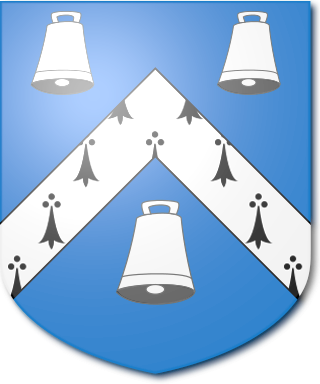Earl of Bradford is a title that has been created twice, once in the Peerage of England and once in the Peerage of the United Kingdom. It was first created in 1694 for Francis Newport, 2nd Baron Newport. However, all the Newport titles became extinct on the death of the fourth Earl in 1762. The earldom was revived in 1815 for Orlando Bridgeman, 2nd Baron Bradford. The Bridgeman family had previously succeeded to the Newport estates. The title of the peerage refers to the ancient hundred of Bradford in Shropshire, and not, as might be assumed, to the city of Bradford, Yorkshire, or the town of Bradford-on-Avon in Wiltshire.

There have been six baronetcies created for persons with the surname Smyth, two in the Baronetage of England, one in the Baronetage of Great Britain, one in the Baronetage of Ireland and two in the Baronetage of the United Kingdom. One creation is extant as of 2010.
Nineteen baronetcies have been created for persons with the surname Hamilton, eight in the Baronetage of Nova Scotia, one in the Baronetage of England, five in the Baronetage of Ireland, one in the Baronetage of Great Britain and four in the Baronetage of the United Kingdom. As of 2008 two creations are extant, two are dormant, two are either extinct or dormant and twelve extinct.

There have been two Baronetcies created for persons with the surname Allin, both in the Baronetage of England. Both creations are extinct.

There have been two baronetcies created for members of the Whitmore family, one in the Baronetage of England and one in the Baronetage of the United Kingdom. One creation is extinct while the other is extant.
There have been nine baronetcies created for persons with the surname Lloyd, three in the Baronetage of England, three in the Baronetage of Great Britain and three in the Baronetage of the United Kingdom. Two of the creations are extant as of 2010.

There have been twenty one baronetcies created for persons with the surname Williams, eight in the Baronetage of England, three in the Baronetage of Great Britain and ten in the Baronetage of the United Kingdom. Only six of the creations are extant as of 2017.

The Samwell Baronetcy, of Upton in the County of Northampton, was a title in the Baronetage of England. It was created on 22 December 1675 Thomas Samwell, later Member of Parliament for Northamptonshire and Northampton. He was the great-grandson of Sir William Samwell, Auditor of the Exchequer to Queen Elizabeth I of England. The second Baronet sat as Member of Parliament for Coventry. On the death of the fourth Baronet in 1789, the title became extinct.

There have been three baronetcies created for members of the Vernon family.
There have been six baronetcies created for persons with the surname Thomas, three in the Baronetage of England, one in the Baronetage of Great Britain and two in the Baronetage of the United Kingdom. Two of the creations are extant as of 2016.

There have been five baronetcies created for members of the old established family of Peyton of Peyton Hall in the parish of Boxford in Suffolk, all of whom were descended from Sir Robert Peyton of Isleham in Cambridgeshire, grandson and heir of Thomas Peyton (1418–1484) of Isleham, twice Sheriff of Cambridgeshire and Huntingdonshire, in 1443 and 1453. All the baronetcies are extinct.
There have been two baronetcies- both extinct- granted to the Willises of Fen Ditton, both in the Baronetage of England.
The Thornycroft Baronetcy, of Milcomb in the County of Oxford, was a title in the Baronetage of England. It was created on 12 August 1701 for the barrister, John Thornycroft. The title became extinct on the death of the second Baronet in 1743.

The Rudd Baronetcy, of Aberglassney in the County of Carmarthen, was a title in the Baronetage of England. It was created on 8 December 1628 for Richard Rudd. He was the son of Anthony Rudd, Bishop of St David's. The second baronet sat as member of parliament for Higham Ferrers and Carmarthenshire. The title became extinct on the death of the fourth Baronet in 1739.

The Vandeput Baronetcy, of Twickenham in the County of Middlesex, was a title in the Baronetage of Great Britain. It was created on 7 November 1723 for Peter Vandeput. The title became extinct on the death of the second Baronet in 1784. George Vandeput, illegitimate son of the second Baronet, was an Admiral in the Royal Navy.

The Elwes Baronetcy of Stoke-by-Clare in the County of Suffolk, was a title in the Baronetage of England held by the Elwys family, whose name through the years has alternately been spelled Helwish, Helewise, Helwys, Elwaiss and Elwaies.

There have been three baronetcies created for persons with the surname Meredith, one in the Baronetage of England, one in the Baronetage of Nova Scotia and one in the Baronetage of the United Kingdom. Two of the creations are extinct while one is dormant.

The Marwood Baronetcy, of Little Busby in the County of York, was a title in the Baronetage of England. It was created on 31 December 1660 for George Marwood, Member of Parliament for Malton and Northallerton. The second Baronet also represented Northallerton in Parliament. The title became extinct on the death of the fourth Baronet in 1740.
There have been two baronetcies created for members of the Hussey family, both in the Baronetage of England. Both creations are extinct.
There have been five baronetcies created for persons with the surname Tyrrell, all in the Baronetage of England. All five creations are extinct, as is the Tyrell baronetcy. The six creations all claim a descent from Walter Tirell, the reputed accidental killer of King William II.












